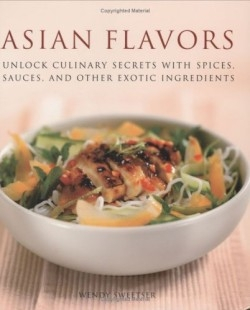
Asian Flavors
Unlock Culinary Secrets with Spices Sauces and Other Exotic Ingredients
Few Baby Boomers who grew up lunching in public school cafeterias escaped ladles of an over-salted, brown glop known as chop suey. That meal passed as an introduction to “Asian” food, despite its dubious and controversial origins (food historians agree it was created on U.S. soil). It was difficult to detect precisely what the dish contained—which was perhaps the sole, tenuous source of its exoticism. The childhood notion that in China, people were eating the stuff by choice (and with gusto) made that part of the globe seem especially perplexing. If they dug a tunnel through the earth, children imagined, they would end up in the dark, strange land of chop suey.
These days, Asian-infused cuisine has proliferated throughout the U.S. Take-away sushi exists in far-flung supermarkets from North Carolina to Michigan. Even staid restaurants serve fare such as miso-glazed codfish and mashed potatoes with the sinus-clearing sting of wasabi butter. But while professional chefs riff with Asian ingredients, cooks at home may still remain a little—shall we say?—verklempt. What to do, exactly, with those gnarled roots of ginger, the pungent, briny fish sauce, and trembling blocks of tofu, so maligned for their alleged lack of flavor? Here, at this point of bewilderment, this book identifies its mission: to guide ordinary folks without fear through the aromatic jungle of fermented soy products, galangal, rice wine, and lime leaves—until they have safely reached a well-laid and colorful table.
The author, food editor of British glossies OK! Magazine and The London Magazine, organizes her tour of Asian food around ten essential flavors, from ginger to sesame. She has developed recipes inspired by a vast, diverse swath of the world, from Korea, land of kimchee, to Singapore, a complex cultural mélange unto itself. Her cookbook focuses on what might be termed homemade “fast food,” dishes that can be made quickly from fresh ingredients. Most recipes in the collection are assembled in three to five steps, no labor-intensive or demanding technique required. From Thai red vegetable curry with squash and sweet potato, to Chinese-style watermelon and lime ice, the fare here succeeds in being vibrant and creative, without daunting the cook.
When the book falters, it is with kind intent. Tailoring dishes to appeal to Western palates, Sweetser at times compromises on authenticity. In Japan, sushi chefs (notoriously ardent purists), for example, would be apoplectic at her insistence on seasoning the rice with sugar and sesame oil. Because the project is ambitious in geographic and cultural scope, Sweetser must also emphasize common denominators among widely divergent cuisines, and in the process, some of their stunning distinctiveness goes missing. But for readers who wish to explore the spectrum of Asian flavors in their own kitchens, this worthy volume will bolster courage—and serve as a grown-up introduction to the world of possibilities beyond chop suey.
Reviewed by
Melanie Drane
Disclosure: This article is not an endorsement, but a review. The publisher of this book provided free copies of the book to have their book reviewed by a professional reviewer. No fee was paid by the publisher for this review. Foreword Reviews only recommends books that we love. Foreword Magazine, Inc. is disclosing this in accordance with the Federal Trade Commission’s 16 CFR, Part 255.
